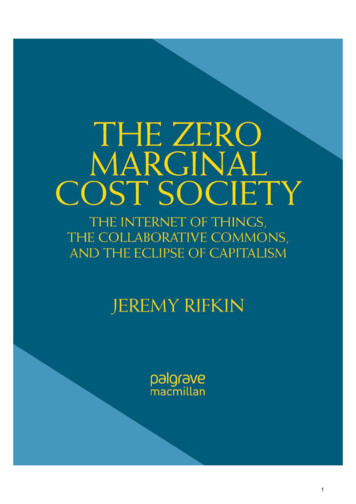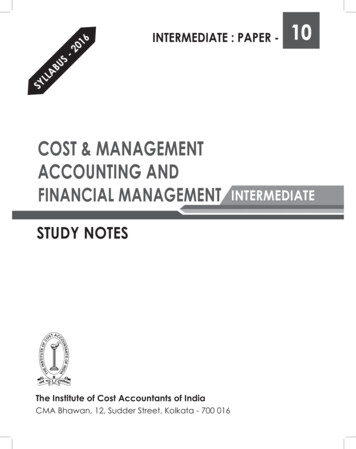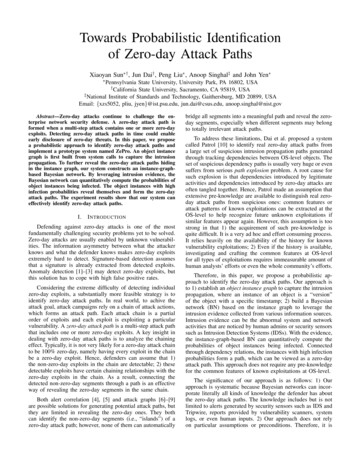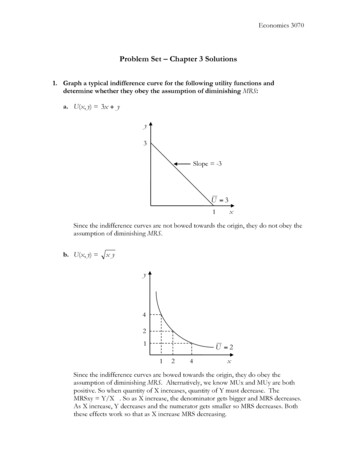
Transcription
1
THEZERO MARGINAL COST SOCIETYTHE INTERNET OF THINGS, THE COLLABORATIVECOMMONS, AND THE ECLIPSE OF CAPITALISMJEREMY RIFKIN2
THE ZERO MARGINAL COST SOCIETYCopyright Jeremy RifkinAll rights reserved.First published in 2014 by PALGRAVE MACMILLAN in the U.S.—a division of St. Martin’s Press LLC, 175 Fifth Avenue, New York, NY 10010.Where this book is distributed in the UK, Europe and the rest of the world, this is by Palgrave Macmillan, a division ofMacmillan Publishers Limited, registered in England, company number 785998, of Houndmills, Basingstoke, Hampshire RG216XS.Palgrave Macmillan is the global academic imprint of the above companies and has companies and representatives throughoutthe world.Palgrave and Macmillan are registered trademarks in the United States, the United Kingdom, Europe and other countries.ISBN: 978-1-137-27846-3Library of Congress Cataloging-in-Publication DataRifkin, Jeremy.The zero marginal cost society : the internet of things, the collaborative commons, and the eclipse of capitalism / Jeremy Rifkin.pages cmISBN 978-1-137-27846-3 (alk. paper)1. Capitalism. 2. Cost. 3. Cooperation. I. Title.HB501.R555 2014330.12’6—dc232013033940A catalogue record of the book is available from the British Library.Design by Letra LibreFirst edition: April 201410 9 8 7 6 5 4 3 2 1Printed in the United States of America.3
CONTENTSAcknowledgments1: The Great Paradigm Shift from Market Capitalism to the Collaborative CommonsPART ITHE UNTOLD HISTORY OF CAPITALISM2: The European Enclosures and the Birth of the Market Economy3: The Courtship of Capitalism and Vertical Integration4: Human Nature through a Capitalist LensPART IITHE NEAR ZERO MARGINAL COST SOCIETY5: Extreme Productivity, the Internet of Things, and Free Energy6: 3D Printing: From Mass Production to Production by the Masses7: MOOCs and a Zero Marginal Cost Education8: The Last Worker Standing9: The Ascent of the Prosumer and the Build-out of the Smart EconomyPART IIITHE RISE OF THE COLLABORATIVE COMMONS10: The Comedy of the Commons11: The Collaboratists Prepare for Battle12: The Struggle to Define and Control the Intelligent InfrastructurePART IVSOCIAL CAPITAL AND THE SHARING ECONOMY13: The Transformation from Ownership to Access14: Crowdfunding Social Capital, Democratizing Currency, Humanizing Entrepreneurship, andRethinking WorkPART VTHE ECONOMY OF ABUNDANCE4
15: The Sustainable Cornucopia16: A Biosphere LifestyleAfterword: A Personal NoteNotesBibliographyIndex5
ACKNOWLEDGMENTSlike to thank Lisa Mankowsky and Shawn Moorhead for the extraordinary work they did inI wouldoverseeing and editing The Zero Marginal Cost Society. Virtually every book is a collaborativeeffort. An author’s effectiveness depends, to a great extent, on the individuals who work with him inthe preparation of a manuscript. Mr. Moorhead and Ms. Mankowsky are a dream team. Mr. Moorheadpaid particular attention to ensuring the proper integration of themes and conceptual details throughoutthe book. Ms. Mankowsky focused on ensuring a smooth editorial flow throughout the narrative andconsistency in the presentation. Their dedication to the project, keen editorial advice, and wisecounsel were instrumental in shaping the final content. Their contributions can be found on every pageof the final book.I would also like to thank Christian Pollard, who not only assisted in the editorial preparation ofthe book, but who also developed an elegant marketing and outreach campaign for its publication.We had the opportunity of working with some very talented interns during the two-year preparationof The Zero Marginal Cost Society. Their contributions added significantly to the value of the finalwork. Thanks to Dan Michell, Alexandra Martin, Jared Madden, Elizabeth Ortega, James PartlowShuyang “Cherry” Yu, James Najarian, Daniel McGowan, Gannon McHenry, Kevin Gardner, JustiGreen, and Stan Kozlowski.I’d also like to thank my editor, Emily Carleton, at Palgrave Macmillan, for her enthusiasm for theproject and her many insightful editorial suggestions along the way that helped hone the manuscript.Thanks to my publisher, Karen Wolny, for her unflagging support throughout the process.Finally, as always, I’d like to thank my wife, Carol Grunewald, for the many fruitful conversationsduring the preparation of the book that helped shape my thinking and tighten the arguments in the text.Quite frankly, Carol is the best editor and wordsmith I’ve ever known.Writing this book was a pleasure and a true labor of love. I hope readers will enjoy the book asmuch as I enjoyed writing it.6
CHAPTER ONETHE GREATPARADIGM SHIFT FROMMARKET CAPITALISM TO THECOLLABORATIVE COMMONShe capitalist era is passing . . . not quickly, but inevitably. A new economic paradigm—theCollaborative Commons—is rising in its wake that will transform our way of life. We arealready witnessing the emergence of a hybrid economy, part capitalist market and partCollaborative Commons. The two economic systems often work in tandem and sometimes compete.They are finding synergies along each other’s perimeters, where they can add value to one another,while benefiting themselves. At other times, they are deeply adversarial, each attempting to absorb orreplace the other.The struggle between these two competing economic paradigms is going to be protracted and hardfought. But, even at this very early stage, what is becoming increasingly clear is that the capitalistsystem that provided both a compelling narrative of human nature and the overarching organizationalframework for the day-to-day commercial, social, and political life of society—spanning more thanten generations—has peaked and begun its slow decline. While I suspect that capitalism will remainpart of the social schema for at least the next half century or so, I doubt that it will be the dominanteconomic paradigm by the second half of the twenty-first century. Although the indicators of the greattransformation to a new economic system are still soft and largely anecdotal, the CollaborativeCommons is ascendant and, by 2050, it will likely settle in as the primary arbiter of economic life inmost of the world. An increasingly streamlined and savvy capitalist system will continue to soldieron at the edges of the new economy, finding sufficient vulnerabilities to exploit, primarily as anaggregator of network services and solutions, allowing it to flourish as a powerful niche player in thenew economic era, but it will no longer reign.I understand that this seems utterly incredible to most people, so conditioned have we become tothe belief that capitalism is as indispensable to our well-being as the air we breathe. But despite thebest efforts of philosophers and economists over the centuries to attribute their operating assumptionsto the same laws that govern nature, economic paradigms are just human constructs, not naturalphenomena.As economic paradigms go, capitalism has had a good run. Although its timeline has beenrelatively short compared to other economic paradigms in history, it’s fair to say that its impact on thehuman journey, both positive and negative, has been more dramatic and far-reaching than perhaps anyother economic era in history, save for the shift from foraging/hunting to an agricultural way of life.T7
Ironically, capitalism’s decline is not coming at the hands of hostile forces. There are no hordes atthe front gates ready to tear down the walls of the capitalist edifice. Quite the contrary. What’sundermining the capitalist system is the dramatic success of the very operating assumptions thatgovern it. At the heart of capitalism there lies a contradiction in the driving mechanism that haspropelled it ever upward to commanding heights, but now is speeding it to its death.THE ECLIPSE OF CAPITALISMCapitalism’s raison d’être is to bring every aspect of human life into the economic arena, where it istransformed into a commodity to be exchanged as property in the marketplace. Very little of the humanendeavor has been spared this transformation. The food we eat, the water we drink, the artifacts wemake and use, the social relationships we engage in, the ideas we bring forth, the time we expend, andeven the DNA that determines so much of who we are have all been thrown into the capitalistcauldron, where they are reorganized, assigned a price, and delivered to the market. Through most ofhistory, markets were occasional meeting places where goods were exchanged. Today, virtuallyevery aspect of our daily lives is connected in some way to commercial exchanges. The marketdefines us.But here lies the contradiction. Capitalism’s operating logic is designed to fail by succeeding. Letme explain.In his magnum opus, The Wealth of Nations, Adam Smith, the father of modern capitalism, positsthat the market operates in much the same way as the laws governing gravity, as discovered by IsaacNewton. Just as in nature, where for every action there is an equal and opposite reaction, so too dosupply and demand balance each other in the self-regulating marketplace. If consumer demand forgoods and services goes up, sellers will raise their prices accordingly. If the sellers’ prices becometoo high, demand will drop, forcing sellers to lower the prices.The French Enlightenment philosopher Jean-Baptiste Say, another early architect of classicaleconomic theory, added a second assumption, again borrowing a metaphor from Newtonian physics.Say reasoned that economic activity was self-perpetuating, and that as in Newton’s first law, onceeconomic forces are set in motion, they remain in motion unless acted upon by outside forces. Heargued that “a product is no sooner created, than it, from that instant, affords a market for otherproducts to the full extent of its own value. . . . The creation of one product immediately opens a ventfor other products.”1 A later generation of neoclassical economists refined Say’s Law by assertingthat new technologies increase productivity, allowing the seller to produce more goods at a cheapercost per unit. The increased supply of cheaper goods then creates its own demand and, in the process,forces competitors to invent their own technologies to increase productivity in order to sell theirgoods even more cheaply and win back or draw in new customers (or both). The entire processoperates like a perpetual-motion machine. Cheaper prices, resulting from new technology andincreased productivity, mean more money left over for consumers to spend elsewhere, which spurs afresh round of competition among sellers.There is a caveat, however. These operating principles assume a competitive market. If one or afew sellers are able to outgrow and eliminate their competition and establish a monopoly oroligopoly in the market—especially if their goods and services are essential—they can keep prices8
artificially high, knowing that buyers will have little alternative. In this situation, the monopolist hasscant need or inclination to bring on new labor-saving technologies to advance productivity, reduceprices, and remain competitive. We’ve seen this happen repeatedly throughout history, if only forshort periods of time.In the long run, however, new players invariably come along and introduce breakthroughs intechnology that increase productivity and lower prices for similar or alternative goods and services,and break the monopolistic hold on the market.Yet suppose we carry these guiding assumptions of capitalist economic theory to their logicalconclusion. Imagine a scenario in which the operating logic of the capitalist system succeeds beyondanyone’s wildest expectations and the competitive process leads to “extreme productivity” and whateconomists call the “optimum general welfare”—an endgame in which intense competition forces theintroduction of ever-leaner technology, boosting productivity to the optimum point in which eachadditional unit introduced for sale approaches “near zero” marginal cost. In other words, the cost ofactually producing each additional unit—if fixed costs are not counted—becomes essentially zero,making the product nearly free. If that were to happen, profit, the lifeblood of capitalism, would dryup.In a market-exchange economy, profit is made at the margins. For example, as an author, I sell myintellectual work product to a publisher in return for an advance and future royalties on my book. Thebook then goes through several hands on the way to the end buyer, including an outside copyeditor,compositor, printer, as well as wholesalers, distributors, and retailers. Each party in this process ismarking up the transaction costs to include a profit margin large enough to justify their participation.But what if the marginal cost of producing and distributing a book plummeted to near zero? In fact,it’s already happening. A growing number of authors are writing books and making them available ata very small price, or even for free, on the Internet—bypassing publishers, editors, printers,wholesalers, distributors, and retailers. The cost of marketing and distributing each copy is nearlyfree. The only cost is the amount of time consumed by creating the product and the cost of computingand connecting online. An e-book can be produced and distributed at near zero marginal cost.The near zero marginal cost phenomenon has already wreaked havoc on the publishing,communications, and entertainment industries as more and more information is being made availablenearly free to billions of people. Today, more than one-third of the human race is producing its owninformation on relatively cheap cellphones and computers and sharing it via video, audio, and text atnear zero marginal cost in a collaborative networked world. And now the zero marginal costrevolution is beginning to affect other commercial sectors, including renewable energy, 3D printing inmanufacturing, and online higher education. There are already millions of “prosumers”—consumerswho have become their own producers—generating their own green electricity at near zero marginal cost around the world. It’s estimated thataround 100,000 hobbyists are manufacturing their own goods using 3D printing at nearly zeromarginal cost.2 Meanwhile, six million students are currently enrolled in free Massive Open OnlineCourses (MOOCs) that operate at near zero marginal cost and are taught by some of the mosdistinguished professors in the world, and receiving college credits. In all three instances, while theup-front costs are still relatively high, these sectors are riding exponential growth curves, not unlike9
the exponential curve that reduced the marginal cost of computing to near zero over the past severaldecades. Within the next two to three decades, prosumers in vast continental and global networks willbe producing and sharing green energy as well as physical goods and services, and learning in onlinevirtual classrooms at near zero marginal cost, bringing the economy into an era of nearly free goodsand services.Many of the leading players in the near zero marginal cost revolution argue that while nearly freegoods and services will become far more prevalent, they will also open up new possibilities forcreating other goods and services at sufficient profit margins to maintain growth and even allow thecapitalistic system to flourish. Chris Anderson, the former editor of Wired magazine, reminds us thatgiveaway products have long been used to draw potential customers into purchasing other goods,citing the example of Gillette, the first mass producer of disposable razors. Gillette gave away therazors to hook consumers into buying the blades that fit the devices.3Similarly, today’s performing artists often allow their music to be shared freely online by millionsof people with the hope of developing loyal fans who will pay to attend their live concerts. The NewYork Times and The Economist provide some free online articles to millions of people in anticipationthat a percentage of the readers will choose to pay for more detailed reporting by subscribing.“Free,” in this sense, is a marketing device to build a customer base for paid purchases.These aspirations are shortsighted, and perhaps even naïve. As more and more of the goods andservices that make up the economic life of society edge toward near zero marginal cost and becomealmost free, the capitalist market will continue to shrink into more narrow niches where profit-makingenterprises survive only at the edges of the economy, relying on a diminishing consumer base for veryspecialized products and services.The reluctance to come to grips with near zero marginal cost is understandable. Many, though notall, of the old guard in the commercial arena can’t imagine how economic life would proceed in aworld where most goods and services are nearly free, profit is defunct, property is meaningless, andthe market is superfluous. What then?Some are just beginning to ask that question. They might find some solace in the fact that several ofthe great architects of modern economic thinking glimpsed the problem long ago. John MaynardKeynes, Robert Heilbroner, and Wassily Leontief, to name a few, pondered the critical contradictionthat drove capitalism forward. They wondered whether, in the distant future, new technologies mightso boost productivity and lower prices as to create the coming state of affairs.Oskar Lange, a University of Chicago professor of the early twentieth century, captured a sense ofthe conundrum underlying a mature capitalism in which the search for new technological innovationsto advance productivity and cheapen prices put the system at war with itself. Writing in 1936, in thethroes of the Great Depression, he asked whether the institution of private ownership of the means ofproduction would continue indefinitely to foster economic progress, or whether at a certain stage oftechnological development the very success of the system would become a shackle to its furtheradvance.4Lange noted that when an entrepreneur introduces technological innovations that allow him tolower the price of goods and services, he gains a temporary advantage over competitors strappedwith antiquated means of production, resulting in the devaluation of the older investments they are10
locked into. This forces them to respond by introducing their own technological innovations, againincreasing productivity and cheapening prices and so on.But in mature industries where a handful of enterprises have succeeded in capturing much of themarket and forced a monopoly or oligopoly, they would have every interest in blocking furthereconomic progress in order to protect the value of the capital already invested in outmodedtechnology. Lange observes that “when the maintenance of the value of the capital already investedbecomes the chief concern of the entrepreneurs, further economic progress has to stop, or, at least, toslow down considerably. . . . This result will be even more accentuated when a part of the industriesenjoy a monopoly position.”5Powerful industry leaders often strive to restrict entry of new enterprises and innovations. Butslowing down or stopping new, more productive technologies to protect prior capital investmentscreates a positive-feedback loop by preventing capital from investing in profitable new opportunities.If capital can’t migrate to new profitable investments, the economy goes into a protracted stall.Lange described the struggle that pits capitalist against capitalist in stark terms. He writes:The stability of the capitalist system is shaken by the alternation of attempts to stop economic progress in order to protect oldinvestments and tremendous collapses when those attempts fail.6Attempts to block economic progress invariably fail because new entrepreneurs are continuallyroaming the edges of the system in search of innovations that increase productivity and reduce costs,allowing them to win over consumers with cheaper prices than those of their competitors. The raceLange outlines is relentless over the long run, with productivity continually pushing costs and pricesdown, forcing profit margins to shrink.While most economists today would look at an era of nearly free goods and services with a senseof foreboding, a few earlier economists expressed a guarded enthusiasm over the prospect. Keynes,the venerable twentieth-century economist whose economic theories still hold considerable weight,penned a small essay in 1930 entitled “Economic Possibilities for Our Grandchildren,” whichappeared as millions of Americans were beginning to sense that the sudden economic downturn of1929 was in fact the beginning of a long plunge to the bottom.Keynes observed that new technologies were advancing productivity and reducing the cost ofgoods and services at an unprecedented rate. They were also dramatically reducing the amount ofhuman labor needed to produce goods and services. Keynes even introduced a new term, which hetold his readers, you “will hear a great deal in the years to come—namely, technologicalunemployment. This means unemployment due to our discovery of means of economising the use oflabour outrunning the pace at which we can find new uses for labour.” Keynes hastened to add thattechnological unemployment, while vexing in the short run, is a great boon in the long run because itmeans “that mankind is solving its economic problem.”7Keynes believed that “a point may soon be reached, much sooner perhaps than we are all of usaware of, when these [economic] needs are satisfied in the sense that we prefer to devote our furtherenergies to non-economic purposes.”8 He looked expectantly to a future in which machines wouldproduce an abundance of nearly free goods and services, liberating the human race from toil and11
hardships and freeing the human mind from a preoccupation with strictly pecuniary interests to focusmore on the “arts for life” and the quest for transcendence.Both Lange and Keynes foresaw, back in the 1930s, the schizophrenia that lies at the nucleus of thecapitalist system: the inherent entrepreneurial dynamism of competitive markets that drivesproductivity up and marginal costs down. Economists have long understood that the most efficienteconomy is one in which consumers pay only for the marginal cost of the goods they purchase. But ifconsumers pay only for the marginal cost and those costs continue to race toward zero, businesseswould not be able to ensure a return on their investment and sufficient profit to satisfy theirshareholders. That being the case, market leaders would attempt to gain market dominance to ensure amonopoly hold so they could impose prices higher than the marginal cost of the products they’reselling, thus preventing the invisible hand from hurrying the market along to the most efficienteconomy of near zero marginal cost and the prospect of nearly free goods and services. This catch-22is the inherent contradiction that underlies capitalist theory and practice.Eighty years after Lange and Keynes made their observations, contemporary economists are onceagain peering into the contradictory workings of the capitalist system, unsure of how to make themarket economy function without self-destructing in the wake of new technologies that are speedingsociety into a near zero marginal cost era.Lawrence Summers, U.S. secretary of the treasury during President Bill Clinton’s administrationand former president of Harvard University, and J. Bradford DeLong, a professor of economics at theUniversity of California, Berkeley, revisited the capitalist dilemma in a joint paper delivered at theFederal Reserve Bank of Kansas City’s symposium, “Economic Policy for the Information Economy,”in August 2001. This time, there was much more at stake as the new information technologies and theincipient Internet communication revolution were threatening to take the capitalist system to a nearzero marginal cost reality in the coming decades.Summers and DeLong’s concerns focused on the emerging data-processing and communicationtechnologies. They wrote that these “seismic innovations” were forcing a wholesale reconfigurationof commercial life, with potential impacts whose expanse rivaled the advent of electricity. Thetechnological changes afoot, according to Summers and DeLong, were likely to dramatically pushdown marginal costs, which became the departure point for their discussion. They accepted that “themost basic condition for economic efficiency . . . [is] that price equal marginal cost.”9 They furtherconceded that “with information goods, the social and marginal cost of distribution is close tozero.”10 Now the paradox: Summers and DeLong argued thatif information goods are to be distributed at their marginal cost of production—zero—they cannot be created and produced byentrepreneurial firms that use revenues obtained from sales to consumers to cover their [fixed set-up] costs. If information goodsare to be created and produced . . . [companies] must be able to anticipate selling their products at a profit to someone.11Summers and DeLong opposed government subsidies to cover the upfront costs, arguing that theshortcomings of “administrative bureaucracy,” “group-think,” and “red-tape” “destroy theentrepreneurial energy of the market.”12In lieu of government intervention, the two distinguished economists reluctantly suggested thatperhaps the best way to protect innovation in an economy where “goods are produced under12
conditions of substantial increasing returns to scale” was to favor short-term natural monopolies.13Summers and DeLong made the point that “temporary monopoly power and profits are the rewardneeded to spur private enterprise to engage in such innovation.”14 They both realized the bind this putprivate enterprise in, admitting that “natural monopoly does not meet the most basic conditions foreconomic efficiency: that price equal marginal cost.”15 Indeed, the modus operandi of a monopoly,as every economist knows, is to hold back would-be competitors from introducing new innovationsthat increase productivity, reduce marginal costs, and lower the price to customers. Nonetheless,Summers and DeLong concluded that in the “new economy” this might be the only way forward. In anincredible admission, the two acknowledged that “the right way to think about this complex set ofissues is not clear, but it is clear that the competitive paradigm cannot be fully appropriate . . . but wedo not yet know what the right replacement paradigm will be.”16Summers and DeLong found themselves hopelessly trapped. Although economists andentrepreneurs never intended for the capitalist system to self-destruct (they expected it to reignforever), a careful look at its operating logic reveals the inevitability of a future of near zero marginalcost. A near zero marginal cost society is the optimally efficient state for promoting the generalwelfare and represents the ultimate triumph of capitalism. Its moment of triumph, however, alsomarks its inescapable passage from the world stage. While capitalism is far from putting itself out ofbusiness, it’s apparent that as it brings us ever closer to a near zero marginal cost society, its onceunchallenged prowess is diminishing, making way for an entirely new way of organizing economiclife in an age characterized by abundance rather than scarcity.CHANGING THE ECONOMIC PARADIGMThe most intriguing passage in Summers and DeLong’s paper on the contradictions and challengesfacing capitalist theory and practice in the unfolding Information Age is their comment that they “donot yet know what the right replacement paradigm will be.” The fact that they were even alluding tothe likelihood of a new replacement paradigm is suggestive of the anomalies that are building up andcasting a dark shadow on the long-term viability of the existing economic regime.We are, it appears, in the early stages of a game-changing transformation in economic paradigms. Anew economic model is emerging in the twilight of the capitalist era that is better suited to organize asociety in which more and more goods and services are nearly free.The term paradigm shift has been thrown around so much in recent years, in reference to virtuallyany kind of change, that it might be helpful to revisit the words of Thomas Kuhn, whose book TheStructure of Scientific Revolutions made the word paradigm part of the general discourse. Kuhndescribed a paradigm as a system of beliefs and assumptions that operate together to establish anintegrated and unified worldview that is so convincing and compelling that it is regarded astantamount to reality itself. He used the term to refer to standard and nearly universally acceptedmodels in science, like Newtonian physics and Darwinian evolution.17A paradigm’s narrative power rests on its all-encompassing description of reality. Once accepted,it becomes difficult, if not impossible, to question its central assumptions, which appear to reflect thenatural order of things. Alternative explanations of the world are rarely entertained, as they fly in the13
face of what is accepted as unambiguous truth. But this unquestioning acceptance, and refusal toenvision alternative explanations, leads to a festering of inconsistencies that pile up until a tippingpoint is reached where the existing paradigm is torn apart and replaced with a new explanatoryparadigm better able to marshal the anomalies, insights, and new developments into a comprehensivenew narrative.The capitalist paradigm, long accepted as the best mechanism for promoting the efficientorganization of economic activity, is now under siege on two fronts.On the first front, a new generation of interdisciplinary scholarship that has brought togetherpreviously distinct fields—including the ecological sciences, chemistry, biology, engineering,architecture, urban planning, and information technology—is challenging standard economic theory(which is wedded to the metaphors of Newtonian physics) with a new theoretical
The zero marginal cost society : the internet of things, the collaborative commons, and the eclipse of capitalism / Jeremy Rifkin. pages cm ISBN 978-1-137-27846-3 (alk. paper) 1. Capitalism. 2. Cost. 3. Cooperation. I. Title. HB501.R555 2014 330.12'6—dc23 2013033940 A catalogue record of the book is available from the British Library .










